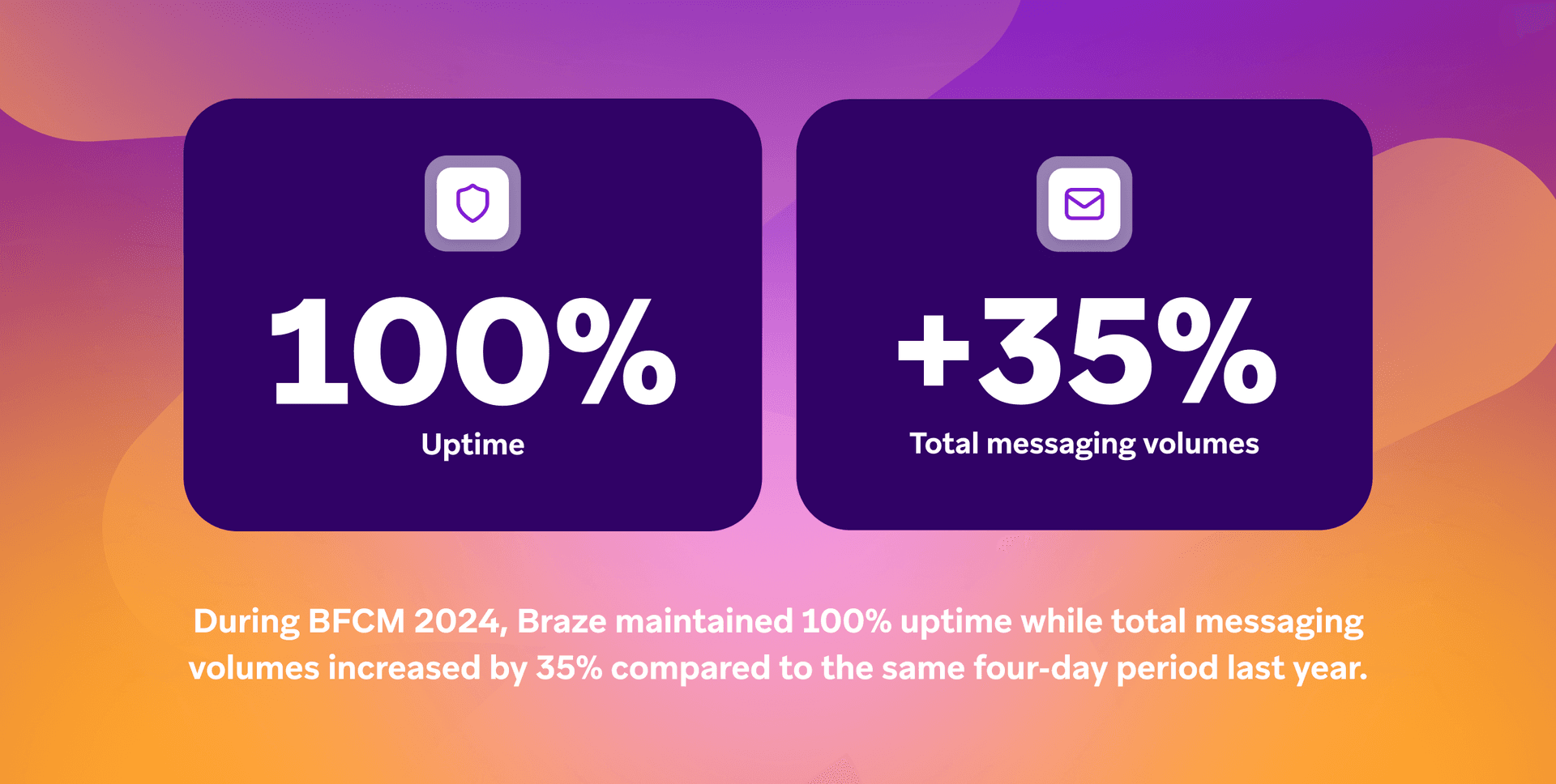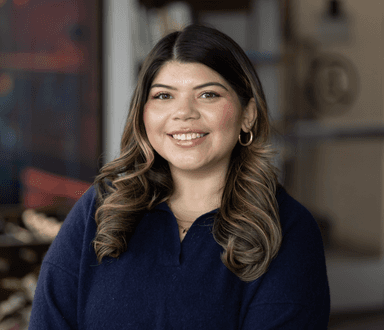What Black Friday and Cyber Monday 2024 tell us about how brands are evolving
Published on December 05, 2024/Last edited on December 05, 2024/7 min read

Jamie Doheny
VP, Technology Services & Chief of Staff, Engineering, BrazeOver the years, the Black Friday and Cyber Monday (BFCM) shopping period has evolved alongside overall retail trends, becoming an increasingly digital shopping experience. What began as a single day of store-based sales has now become a digital-heavy event that lasts upwards of a week and drives billions in revenue.
If you look at your inbox or browse the web, it's clear that brands are sending more BFCM messages than before—and that some brands do it much better than others. To rise above the increased competition for consumer attention, successful brands are getting smarter about how they engage their audiences. They’re no longer relying solely on simple campaigns and one-size-fits-all discounts. Instead, they are embracing sophisticated, personalized, and cross-channel strategies to connect with individual shoppers at scale.
We have a front-row seat as our customers leverage the Braze platform to create standout customer engagement during this key period. Let's take a look at some of the trends we're seeing this year, and what they mean for customer engagement.
What We Saw: Higher Volumes, Growing Messaging Sophistication
It happens like clockwork—Black Friday dawns and we watch messaging volumes go through the roof, surpassing any previous day, and any previous year. During the four-day BFCM period this year, brands using Braze sent more than 50 billion messages, breaking our previous records for send volumes during this period. That included 13.9 billion messages sent on Black Friday and 13.2 billion messages on Cyber Monday. The sheer size of these sends speak to the increasing reliance on digital channels to drive brands’ engagement and monetization efforts during this key shopping period.

The send volumes we saw this year showcase this evolution, highlighting how integral customer engagement has become to the way this key shopping holiday plays out for brands and consumers alike.

While the uplift in message sends tells an important story, the focus on volumes can obscure an even more significant development. Our research found that it wasn’t just sending volumes that increased during this year’s BFCM period. The sophistication and nuance of the messaging being sent via Braze also significantly expanded across multiple different approaches. This reflects a more competitive market, where consumers have come to expect differentiated experiences—and abandon brands who don’t meet their expectations.

This year’s BFCM findings tell the story of evolution: We’re moving even further away from the batch-and-blast or single campaigns of old, to dynamic, data-informed campaigns that reach customers across the full variety of channels they frequent.
The increase in multi-step campaigns orchestrated using Braze Canvas reflects a growing sense that marketers need to embrace multiple channels and responsive, automated customer journeys to get and hold their customers’ attention during the holiday period. While BFCM is often associated with retailers sending high volumes of generic discount messages, this key shopping period also represents an opportunity for brands to drive stronger performance by segmenting customers more precisely based on their engagement and buying habits. Done right, this approach can increase customer touchpoints, optimizing engagement and nurturing customers throughout the BFCM period to maximize their purchase potential.
The growing number of messages being sent by brands reinforces what your own mobile device is probably telling you—namely, that customers are getting more messages across more channels, particularly during this time of year. BFCM send volumes have continually increased YoY, reinforcing the importance of thoughtfully considering outreach frequency and cadence in customer messaging: After all, the goal is to make your brand messages unmissable, without becoming overwhelming.

While Braze saw significant overall growth when it came to send volumes across channels, some specific ones were especially strong this year. In particular, connected TV messages sent via Roku stood out among a growing channel landscape, sporting the highest year over year growth. Beyond that, WhatsApp, Content Cards, and in-app messages also experienced major growth, further demonstrating that brands are moving to more sophisticated, cross-channel campaigns. It’s not just about push and email anymore—there’s a diverse landscape of channels that can be used to connect with customers.
Finally, we saw high usage of many of our editing and building tools during the BFCM period. Our Drag-and-Drop Editor for Email was used by 53% of our customers, while 20% used the Drag-and-Drop Editor for In-App Messages and 37% used the Email HTML Editor. This, coupled with the message volume increase, helps show how Braze customers are sending more messages than ever before with more ease-of-use.
Uptime is Essential: How Braze Maintained 100% Uptime During BFCM
Delivering flawless BFCM campaigns at today’s massive scale takes a robust platform like Braze, built to maximize scalability, uptime, and deliverability during retail’s busiest season. We take this responsibility extremely seriously. Our customers trust us to deliver and preparation begins months in advance to make sure we do.
Two months and counting
- Our Capacity Planning Change Advisory Board and Customer Success teams meet to forecast message volumes and identify potential stress points
- We scale infrastructure and resources—expanding databases, increasing network bandwidth, and optimizing sending services
Weeks to go
- We implement a code freeze to support maximum platform stability
- We fine-tune deliverability systems to help every message reaches its destination
- We confirm with our sub-processors they are ready to handle the volume, and we have appropriate escalation call trees in place, if necessary
During the event
- Real-time monitoring and on-call teams provide additional safeguards
- We increase the number of people on call, based on anticipated volumes, in order to support customers and troubleshoot any technical questions
- Our most senior and tenured team members are on hand to ensure everything goes smoothly
This proactive approach means Braze delivers the outstanding reliability, deliverability, and performance you depend on, to maximize engagement and revenue on the busiest shopping days of the year.
Looking Ahead: Three Strategies for BFCM 2025
Looking ahead to Black Friday and Cyber Monday 2025, brands can expand their impact by:
- Starting earlier: Engage customers before Black Friday with “sneak peek” campaigns to pique their interest. Offer early access to loyal customers. And personalize outreach with products you know they’ll want to grab on sale.
- Following through better: Use post-sale messages to build confidence in and commitment to your brand—like convenient order and delivery updates, personalized recommendations, and options to provide personal data. You can also retarget customers based on how they’ve previously interacted with your brand. Every touchpoint is an opportunity to elevate the customer journey.
- Exploring emerging channels: Use intuitive A/B/n testing and experimentation in Braze to explore the potential of new platforms to reach untapped audiences. This year has seen significant growth in Roku and WhatsApp channels, as marketers continue to adapt to the growing landscape of channels to meet customers where they prefer.
These strategies don’t just drive immediate interest and engagement, they lay the foundations for longer customer lifetimes and loyalty, ensuring Black Friday/Cyber Monday campaigns deliver value beyond a single season.
Want to learn how to get ahead of next year? Check out our webinar “How to Navigate Consumer Trends Shaping 2025.“
Forward Looking Statements
This blog post contains “forward-looking statements” within the meaning of the “safe harbor” provisions of the Private Securities Litigation Reform Act of 1995, including but not limited to, statements regarding the anticipated performance of and benefits from Braze and its products. These forward-looking statements are based on the current assumptions, expectations and beliefs of Braze, and are subject to substantial risks, uncertainties and changes in circumstances that may cause actual results, performance or achievements to be materially different from any future results, performance or achievements expressed or implied by the forward-looking statements. Further information on potential factors that could affect Braze results are included in the Braze Quarterly Report on Form 10-Q for the fiscal quarter ended July 31, 2024, filed with the U.S. Securities and Exchange Commission on September 6, 2024, and the other public filings of Braze with the U.S. Securities and Exchange Commission. The forward-looking statements included in this blog post represent the views of Braze only as of the date of this blog post, and Braze assumes no obligation, and does not intend to update these forward-looking statements, except as required by law.
Related Tags
Be Absolutely Engaging.™
Sign up for regular updates from Braze.
Related Content
View the Blog
The new inbox reality: How iOS changes are reshaping email marketing

Aparna Prasad

Experience optimization: Turning data insights into better journeys

Team Braze

December 2025 Bonfire Marketer of the Month: Jagex’s Emma Oliver
